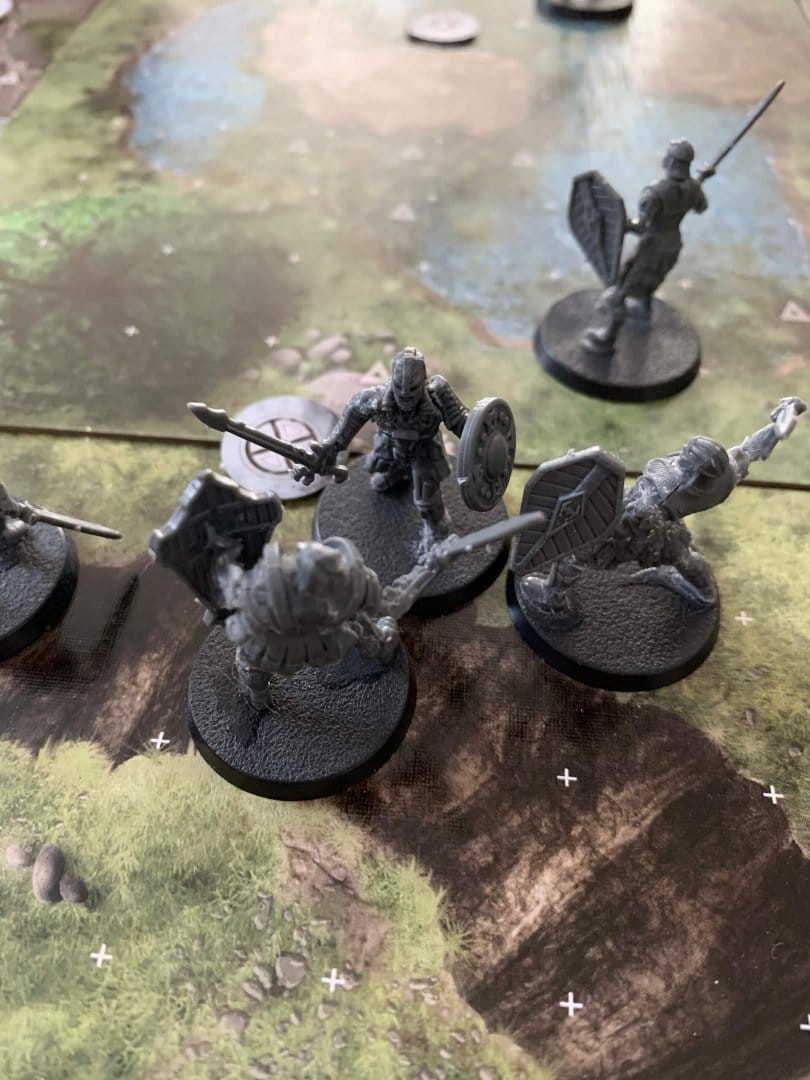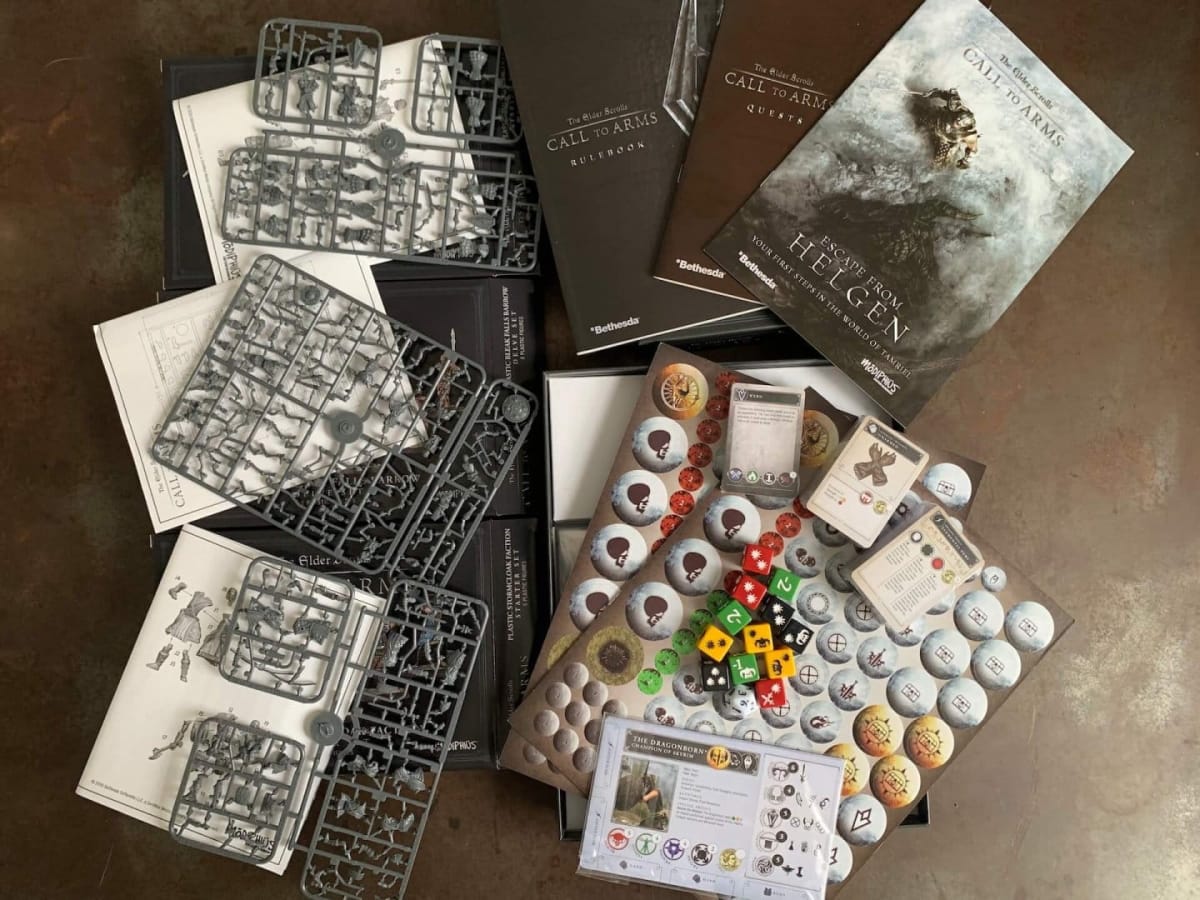The Dragonborn sprints through the tall grass, burning their stamina to get close enough to unleash a devastating dragon shout against a shambling skeleton. Somewhere else in Tamriel, a group of Imperial Legion officers shoulder their shields and brace against a wave of charging Stormcloak rebels. Blades clash, spells fly through the air, tape measurers are unfurled, and custom dice are rolled to determine the fate of the battle. This is The Elder Scrolls: Call To Arms, a new tabletop wargame by Modiphius, based (obviously) on the best selling Elder Scrolls video game series, and it's ushering in a lot of exciting new ideas to the wargaming market.
Two Ways To Play
What makes The Elder Scrolls: Call To Arms so interesting, and sets it apart from more traditional wargames, is its two very different game modes. First, there’s the more traditional Battle Mode, where players take on the role of a faction of heroes, equip them with gear, spells, and abilities based on a point-buy system, and square off against each other. And even in this more straightforward mode, there are interesting twists to explore, like hero characters that can level up, treasure that can be pilfered and equipped on the spot, and non-player enemies that spawn and attack both sides of the battle indiscriminately.
The second mode, Delve Mode, is a solo (or co-op) mode where waves of these non-player enemies, called adversaries, spawn and attempt to smite your heroes. This is really the shining star of this game system, as these adversaries are controlled by a very comprehensive sort of “cardboard AI.” Each time it’s an enemy’s turn to activate, the player rolls a die, consults a small chart, and follows directions on how that enemy should act. In the Delve games I played at home (running a stalwart group of Imperial Soldiers), the Skeleton Archers skittered around finding a good place to hide, the Draugr ran into the thick of the battle with their two-handed greatswords, and the Draugr Overlord was, well, really damn hard to kill. Once you wrap your head around the rules and figure out the flow of Delve Mode, it flows naturally and rather quickly (as far as wargames go).

Playing The Game
The first wave of products hitting stores soon is made up of 4 key pieces. First, there’s the base box, which includes the core rulebook, a book of quests, and a quick-start guide, along with custom dice, equipment cards, quest, special event cards, character cards, and tokens galore. But you’ll need some miniatures, and the first offerings include a 2 faction starter sets, Stormcloaks and the Imperial Legion, and a Bleak Falls Barrow Delve starter set, which includes one hero “The Dragonborn” (the only character in this initial release who can use Dragon Shouts), and a smattering of enemies (skeleton archers and Draugr). One interesting thing to note is that, at least for now, these enemies aren’t a playable faction. They serve as the AI adversaries mentioned above that creep out of long-forgotten tombs.

The core mechanic of the game is quite approachable. Each character model has 5 stats: Strength, Agility, Endurance, Intelligence, and Wisdom, with values attributed to each. When you want to make an attack, or make an ability check (for things like jumping over chasms, shrugging off the effects of a malady, etc.) you roll a custom 20-sided die (with values going up to 10, and other special symbols) and hope to score equal to or under that number.
Simultaneously, when attacking, you’ll also roll a set number of custom 6-sided dice as determined by your weapon. Yellow, red, and black dice show you how much damage you’re dealing, and a custom green die includes negative number modifiers that help you get under your target score. If you beat your own score, you hit. Apply the damage pips, your opponent rolls to see if they negate any of that damage, and that’s that. Seeing as this is, at its heart, a skirmish game, you’re not rolling a bucketful of tiny dice, and the entire system moves at a tidy pace once you learn what all the symbols mean.
That Elder Scrolls Feel
The Elder Scrolls: Call To Arms truly captures the feel of its source material, and it does so in a lot of little, interesting ways. Your characters can move 6 inches, but if you spend stamina points (each character’s stamina pool is different) you can boost your move an extra 3 inches per point. This simple little mechanic so perfectly mirrors the feeling of sprinting for dear life out of a dangerous situation that was so paramount to my Oblivion and Skyrim playthroughs. And then there’s the treasure. Treasure chests litter the battlefield in most games, some of which open right up, while others need to be lock-picked or busted open. And when you find the treasure inside (drawing from a random deck of treasure cards) you can switch out your kit to better suit your needs.

Getting to know the game can be daunting for newcomers to wargaming. I’m no seasoned pro (though I’ve leafed through more than enough Warhammer, Infinity, and Guild Ball rulebooks in my life), so flipping between the rule book, quick reference sheet, and quest guide my first few playthroughs was a bit of a struggle. But once I got a handle on the sequence of play and the general vocabulary of the game I was off to the races and happily smiting my foes (except for that damn Draugr Overlord, he mostly remained un-smited).
Another barrier for newcomers to wargaming is the hobby aspect. Even though this is a big-name, recognizable IP, the models in these beginning sets are not to be taken lightly. These are not push-fit models like Star Wars: Legion, and I particularly struggled to put together the Skeleton Archers (I still shudder at the thought of gluing their tiny arms to their tiny shoulders). But when all’s said and done, they look fantastic on the table, even unpainted.

Though only Stormcloaks, Imperial Legion, a smattering of undead, and a Dragonborn are coming out in this initial release, the rulebook gives a clue of things to come. Special rules for all races from the video games, yes, including Khajit and my beloved Argonians, those water-breathing angels are included. We also get glimpses of tantalizing upcoming foes, like vampires and Animunculi, scattered throughout.
The Bottom Line
This really does hit so many sweet spots for me. I love The Elder Scrolls as a property and I love wargaming but have a very hard time getting anything to the table. I can’t express what a major boon it is to be able to build and customize my fighting units, delve for treasure, and defeat my enemies without having to convince my D&D group or my euro-gaming friends to learn an entire wargame. The pace is quick (and can be quite deadly), and it truly captures the feel of adventuring around Skyrim, trying to learn what it means to be a Dragonborn. Suffice it to say, I think The Elder Scrolls: Call To Arms is really something special, and if you’re into the original series and interested in wargaming, this should be a no-brainer.

Get this game if:
You’re a fan of The Elder Scrolls
You want to play tactical miniature wargames but have a hard time getting them to the table
You just want to be able to scream FUS RO DAH at tiny bits of plastic
Avoid this game if:
You don’t want to get into the hobby aspect of wargaming
You prefer a more traditional wargame
You’re more of a Fallout person (Modiphius has a game for that, too)
The copy of The Elder Scrolls: Call To Arms used in this review was provided by Modiphius.
Review Summary
Have a tip, or want to point out something we missed? Leave a Comment or e-mail us at tips@techraptor.net












